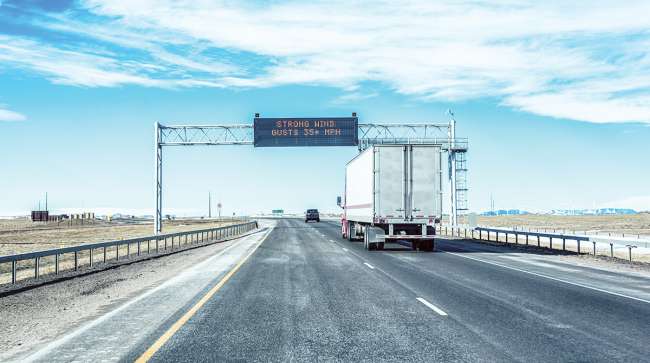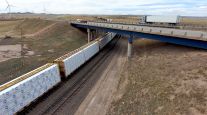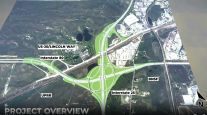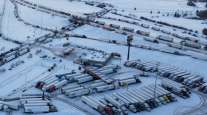Staff Reporter
Wyoming Officials Put Alternative to I-80 on Funding Wish List

[Stay on top of transportation news: Get TTNews in your inbox.]
Despite a possible $6 billion cost, Wyoming transportation officials hope the federal government will fund an alternative route to a hazardous 100-mile stretch of the Interstate 80 mountain corridor where hurricane-force winds and snow cause accidents, heavy truck blow-overs and supply chain disruptions.
Much of Wyoming is located within the Rocky Mountain ranges. I-80 is a 402-mile, east-west state corridor (connecting the capital Cheyenne with Rawlins and Laramie) that handles 32 million tons of freight annually, according to the U.S. Department of Transportation.
In 2020, the average annual daily traffic traveling on I-80 between Laramie and Rawlins ranged from 5,400 to 9,600 total vehicles, with a steady volume of 3,400 trucks, Wyoming Department of Transportation statistics show.
When federal DOT officials informally reached out to WYDOT for “dream projects” as President Joe Biden’s administration began to assess infrastructure investments, they asked what WYDOT would tackle if it could do whatever it wanted, said Doug McGee, WYDOT public affairs director.
The resounding answer was to provide an alternative route for vehicles to take when storms cause I-80 to close, as is often the case, McGee said.
“It would give drivers another way to get around the worst of a storm by not taking a more mountainous route. Right now, there isn’t really a suitable alternate way for people to get across the state if there’s bad weather,” explained Jordan Achs, WYDOT senior public relations specialist.

Achs
Numerous studies and statistics over the years by federal and state DOT officials highlight dangers along I-80. In 2021, there were 1,588 crashes, 831 involving commercial vehicles, that resulted in 188 injuries and six fatalities.
According to WYDOT, snow and blowing snow are factors in the most winter-related traffic crashes (49%). The state also has a high number of vehicles crashing into snowplows — 225 in five years.
A WYDOT highway safety report for November-December 2021 stated that winds with 30 to 40 mph speeds, plus gusts that can be classified as a Category 2 hurricane (96 to 110 mph), cause frequent vehicle blow-over crashes on I-80. The months with the most blow-over crashes — averaging 114 per year — are February, December, November and January. Trucks over 26,000 pounds were the most common type of vehicle involved, at 45%, in all blow-over crashes from 2016-2020.
“We see continuous, hourslong, sometimes dayslong, closings when the weather gets bad,” said Sheila Foertsch, managing director of the Wyoming Trucking Association. “It’s an impact on the supply chain. Then it also puts an impact on other highways when drivers decide they don’t want to wait for eight hours or longer for the highway to be closed.”
The $6 billion cost was a preliminary engineering figure based on current construction and right-of-way acquisition costs to create a 100-mile alternate route between Laramie and Rollins alongside the current, two-lane state Highway 30, Achs said.
“To put it into perspective, it takes us five years to spend $1 billion in construction so a project on this scale is of a much greater scale than we typically do here on a year-to-year basis,” Achs said.

Foertsch
On Jan. 29, Gov. Mark Gordon established a leadership team to coordinate the state’s response to accessing federal Infrastructure Investment and Jobs Act funds.
Foertsch said, “We all agree that the current route of I-80 with its corridor layout has a lot of challenges with the mountain passes, the high elevations and the weather that goes along with that. Rerouting on Highway 30 would come with its own sets of challenges, but certainly we’re interested in any conversations about rerouting.”
She said state officials have explored ways to fund I-80 improvements “but that’s not going to change weather patterns.” There are also constant costs for maintenance and snow removal.
“We’re always interested in options to make any corridor more efficient and safe,” Foertsch said. “If you don’t ask, no one can tell you ‘no.’ You’ve got to figure something out.”
She said the corridor is important year-round and serves a need for passenger vehicle traffic since the interstate is the only road linking communities in the western part of the state.
Want more news? Listen to today's daily briefing below or go here for more info:




